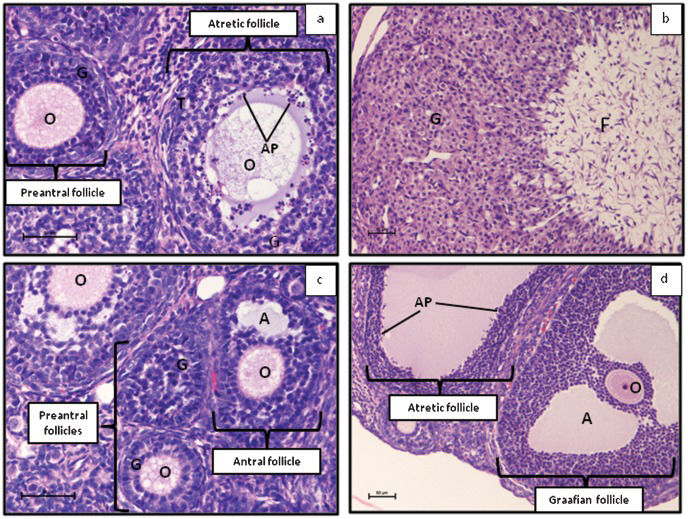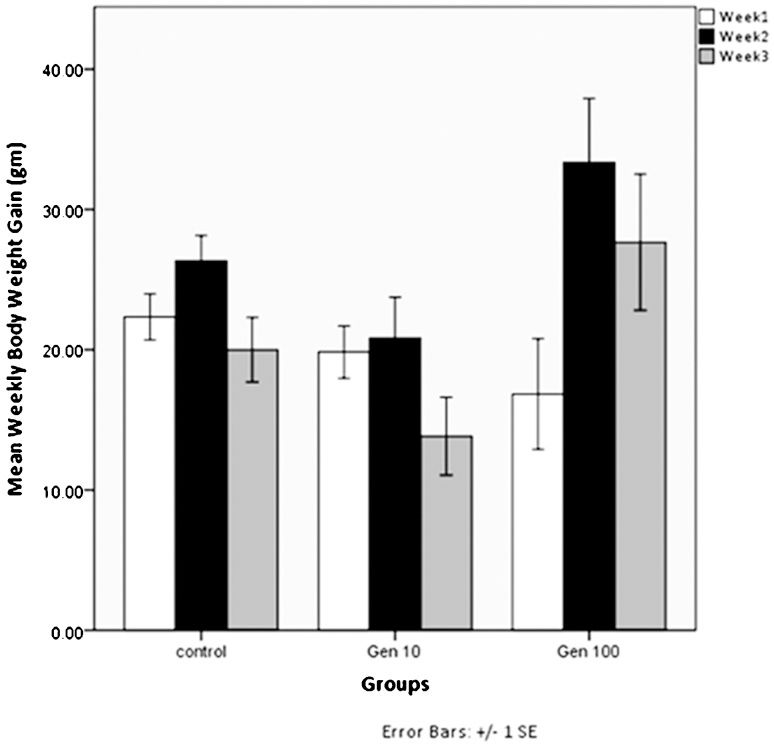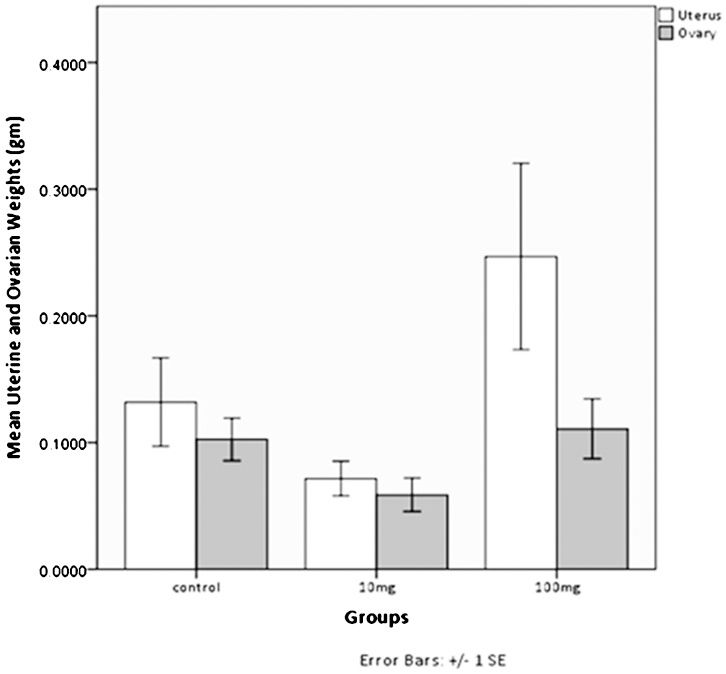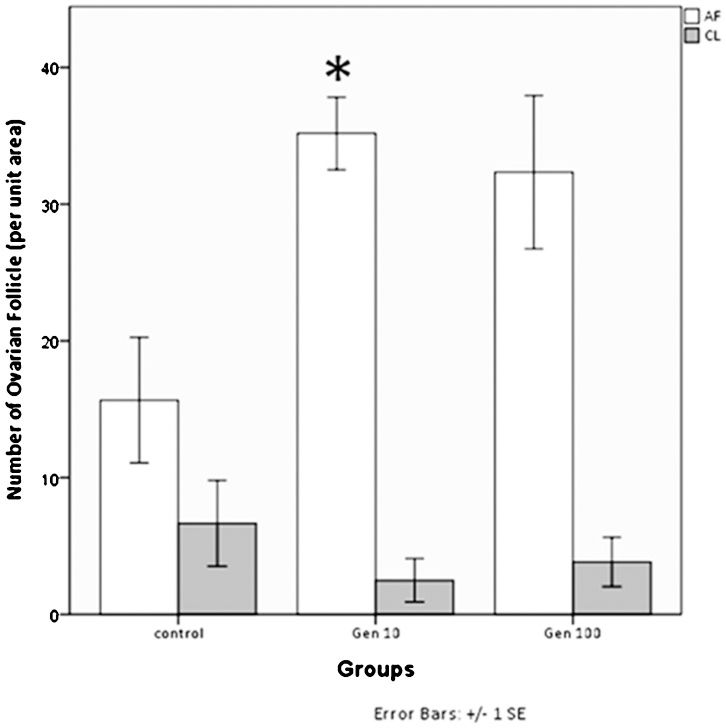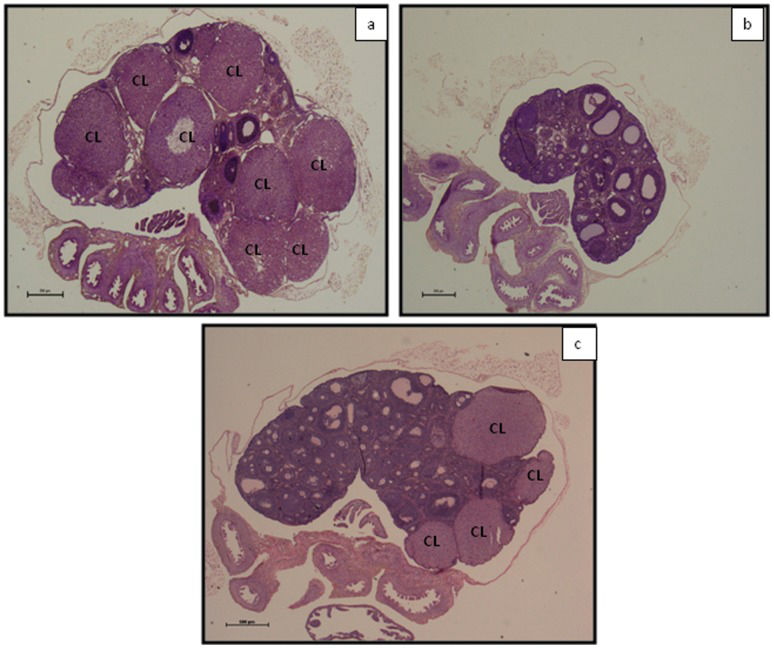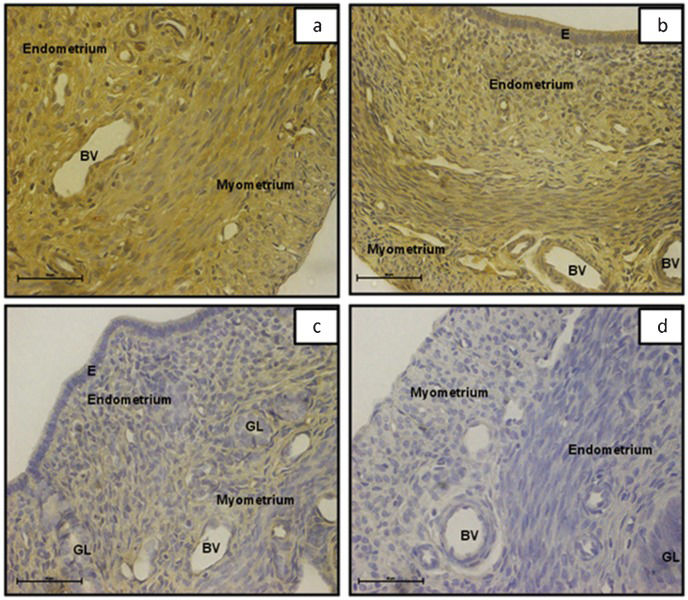Genistein is known to influence reproductive system development through its binding affinity for estrogen receptors. The present study aimed to further explore the effect of Genistein on the development of the reproductive system of experimental rats.
METHODS:Eighteen post-weaning female Sprague Dawley rats were divided into the following groups: (i) a control group that received vehicle (distilled water and Tween 80); (ii) a group treated with 10 mg/kg body weight (BW) of Genistein (Gen 10); and (iii) a group treated with a higher dose of Genistein (Gen 100). The rats were treated daily for three weeks from postnatal day 22 (P22) to P42. After the animals were sacrificed, blood samples were collected, and the uteri and ovaries were harvested and subjected to light microscopy and immunohistochemical study.
RESULTS:A reduction of the mean weekly BW gain and organ weights (uteri and ovaries) were observed in the Gen 10 group compared to the control group; these findings were reversed in the Gen 100 group. Follicle stimulating hormone and estrogen levels were increased in the Gen 10 group and reduced in the Gen 100 group. Luteinizing hormone was reduced in both groups of Genistein-treated animals, and there was a significant difference between the Gen 10 and control groups (p<0.05). These findings were consistent with increased atretic follicular count, a decreased number of corpus luteum and down-regulation of estrogen receptors-α in the uterine tissues of the Genistein-treated animals compared to the control animals.
CONCLUSION:Post-weaning exposure to Genistein could affect the development of the reproductive system of ovarian-intact experimental rats because of its action on the hypothalamic-pituitary-gonadal axis by regulating hormones and estrogen receptors.
The phytoestrogen Genistein belongs to a class of isoflavones found in soybeans, which forms the main dietary source of phytoestrogens for humans, cattle and rodents (1-3). Despite many positive effects that have been reported, questions are being raised regarding their role as endocrine disrupting chemicals (4-6). Some adverse effects have been observed in reproductive tract development and differentiation (7-9).
The action of Genistein varies according to the types of cells, the animal species and the treatment protocol, including the dosage and period of exposure (10-13). Genistein has been reported to exhibit estrogenic activity by causing myometrial hypertrophy in Genistein-treated rats (13). Its ability to suppress mammary cancer demonstrates its anti-estrogenic activity (14-16). Both estrogenic and anti-estrogenic actions of Genistein are associated with the phenolic ring observed in its chemical structure. This feature allows Genistein to bind to estrogen receptors (ER) (12),.
The two types of ER are ER-alpha (α) and ER-beta (β). Both types of ER are found in brain, pituitary, and reproductive tissues, including the uterus and ovary (4),. Genistein has the ability to act as an exogenous ER ligand and to compete with estrogen in the binding of ER (24). As a result, the Genistein-receptor complex may produce an estrogenic or anti-estrogenic effect on the reproductive organs. ER-α and ER-β are primarily located in the uterus and ovary, respectively; it is believed that they act as the main mediators of estrogen action in these organs (4,19).
According to previous studies, Genistein exposure commonly begins during the neonatal period (9,13). However, there are a few reports in which Genistein exposure started during the post-weaning period. In humans, weaning is defined as the period of transition from breastfeeding to other dietary sources (25). Therefore, the chances of being exposed to Genistein-containing food are higher at and after this age (post-weaning). Because the post-weaning age coincides with the critical stage of various neuroendocrine developments, EDC exposure at this point may interrupt this process (26). The main aim of the present study was to further explore the effects of Genistein on the development of the reproductive system in post-weaning Sprague Dawley (SD) rats.
MATERIALS AND METHODSAnimalsEighteen female SD rats at postnatal day 22 (P22) were obtained from Animal Husbandry, University of Malaya (UM). This study was approved by the Animal Care and Committee (ACUC) of UM. SD rats were chosen because this strain is relatively easy to handle and widely used in many animal experiments worldwide (27,28). The rats were housed individually in clean cages at room temperature (24-29°C) with a normal 12-hour light-dark cycle. They had ad libitum access to rat chow (Gold Coin Feedmills Pte. Ltd, Malaysia) and water. The rats were randomly divided into three groups as follows: (i) the Control group received vehicle only (n = 6), (ii) the Gen 10 group received Genistein at a dose of 10 mg/kg body weight (BW) (n = 6), and (iii) the Gen 100 group received Genistein at a dose of 100 mg/kg BW (n = 6).
Chemicals and dosingGenistein (Indofine Chemical Company, Hillsborough, New Jersey, USA) was prepared in the following two doses: low dose (10 mg/kg/day) and high dose (100 mg/kg/day). Tween 80 (Sigma-Aldrich Chemical, St Louis, USA) was used as the vehicle and diluted in distilled water (1:9 v/v). All of the Genistein doses were chosen based on their positive biological effects on female reproductive organs in a preliminary study and other previous studies (13,29,30). The hormonal enzyme-linked immunosorbent standard assay (ELISA) kit was purchased from Cusabio (Newark, Delaware, USA). For the immunohistochemistry (IHC) study, the ER-α was identified using a rabbit polyclonal antibody to ER-α (Abcam Inc., Cambridge, Massachusetts, USA) at a dilution of 1:100.
Experimental proceduresExposure to Genistein was initiated at P22, which was a week prior to the beginning of the natural estrogen rise and two weeks prior to the onset of puberty (around P35) (30). The age of treatment in this study was based on previously described research (30,31). Genistein was administered daily for three weeks via oral gavage tube. The treatment was given orally to mimic the common route of human exposure. At P43, all rats were sacrificed, and blood samples were collected for hormonal analysis. The uteri and ovaries were harvested and processed for light microscopy and IHC.
Hormonal assayBlood samples were collected in EDTA tubes, centrifuged at 1,000 rpm for 15 minutes, and stored at -20°C until hormonal analysis was conducted. Hormones including estrogen, follicle stimulating hormone (FSH) and luteinizing hormone (LH) were measured using an ELISA kit (Cusabio, USA) according to the manufacturer's guidelines. The absorbance at 450 nm was determined using an ELISA microtiter plate reader (BioTek, USA). To calculate the hormone concentration, a standard curve was constructed by plotting a graph of the absorbance of each reference standard against its corresponding concentration.
Histological proceduresThe uterine and ovarian tissues were excised and fixed in 10% formalin (Ajax Finechem, Taren Point, Australia). Following these steps, the tissues were embedded in paraffin (Paraplast, USA) and sectioned at 5-μm thickness. Then, they were deparaffinized with xylene (BDH, England) and hydrated in a series of different concentrations of alcohol (HmbG Chemicals, Germany). Subsequently, the slides were stained with hematoxylin and eosin (H & E), mounted on glass slides and viewed under a light microscope (Olympus CH-BI45-2). Representative uterine tissue sections were chosen for the IHC procedure.
ImmunohistochemistryIHC was conducted to identify ER-α in the uterine tissues using rabbit polyclonal antibody to ER-α. Tissue sections for IHC were subjected to deparaffinization, hydration and blocking of peroxidase activity. These steps were followed by heating the sections in a microwave oven for antigen retrieval using EDTA Tris saline (pH 9). The sections were then incubated overnight at 4°C with primary antibody [rabbit polyclonal antibody to ER-α (Abcam Inc., USA)] diluted at 1:100, washed in Tris-saline (pH 7.6) (Abcam Inc., USA) and incubated at room temperature for 30 minutes with ready-to-use secondary antibody Dako REALTM EnVisionTM Detection System (Abcam Inc., USA). Finally, the tissues were stained with DAB, counter-stained with hematoxylin and viewed under a light microscope (Olympus CH-BI45-2) for evaluation.
AnalysisFor analysis of the ovary, 5-μm tissue sections were sampled and examined under a light microscope (Olympus CH-BI45-2). Morphometric analysis was performed on standard areas of fields that were measured with grid lines using NIS-Elements software (NIS-Elements Advanced Research, Nikon, Japan). Fifty-three representative fields of ovarian tissues from each group were randomly selected. Atretic follicles and corpora lutea were identified, and follicular counts were determined under x400 magnification. Atretic follicles were characterized by the presence of degenerating oocytes and/or apoptotic bodies among the granulosa cells (32,33). In contrast, the corpora lutea were identified by the presence of large pale-staining granulosa lutein cells (Figure 1) (34). Analysis of the uterine wall (endometrium and myometrium) thickness was also performed using the NIS-Elements software (NIS-Elements Advanced Research, Nikon, Japan).
Photomicrographs of the following types of ovarian follicles: (a) atretic and preantral follicles, (b) corpus luteum, (c) preantral and antral follicles and (d) atretic and Graafian follicles. Note the disorganized layers of granulosa cells with apoptotic bodies (AP) in the atretic follicles and the large pale-staining granulosa lutein cells of corpus luteum. A: antrum; O: oocyte; G: granulosa cells; T: theca layer; F: fibroblasts. Scale bar = 50 μm.
For immunohistochemical analysis, the tissue sections were observed under a light microscope for their staining intensity. Representative sections of the ovarian and uterine tissues were photographed with a Nikon Eclipse 80i upright microscope equipped with a digital color camera controller (DS-5Mc-U2).
The quantitative data were then analyzed using SPSS (Version 20.0) statistical software. A one-way ANOVA was used for the analysis. The results are presented as the mean±SEM. Differences were considered statistically significant at p<0.05.
RESULTSBody WeightBW gains were recorded weekly. Reduction of the mean weekly BW gain was observed in the Gen 10 group compared to the control group. In the Gen 100 group, the mean BW gain was reduced during the first week but recovered during subsequent weeks. However, the difference in BW gain between the Genistein-treated and control groups was statistically insignificant (Figure 2).
Uterine and ovarian weightUterine weight was reduced following three-week treatment in the Gen 10 group, but it was increased in the Gen 100 group compared to the control group. Similarly, the ovarian weight was reduced in the Gen 10 group and slightly increased in the Gen 100 group. Nevertheless, the differences in the organ weights in the Genistein-treated rats were not statistically significant compared to those of the control group (Figure 3).
Hormonal assayFollowing the three-week treatment, plasma FSH and estrogen levels were increased in the Gen 10 group but were decreased in the Gen 100 group compared to the control. The plasma LH level was reduced in all of the Genistein-treated groups. However, the reduction was only significant for the Gen 10 group (p<0.05) (Table 1).
Hormone levels following three weeks of treatment. FSH, follicle stimulating hormone; LH, luteinizing hormone. (Control) group given vehicle only; (Gen 10) group treated with Genistein at a dose of 10 mg/kg/day; (Gen 100) group treated with Genistein at a dose of 100 mg/kg/day; n = 6.
| Groups | FSH (mIU/ml) | LH (mIU/ml) | Estrogen (pg/ml) |
|---|---|---|---|
| Control | 35.13±8.62 | 1.93±0.66 | 43.64±8.18 |
| Gen 10 | 45.51±13.13 | 0.37±0.12∗) | 63.74±12.47 |
| Gen 100 | 16.44±2.71 | 0.75±0.25 | 37.31±4.65 |
The values are expressed as the mean±SEM.
Animals in the Gen 10 group exhibited a reduction in the thickness of the endometrium and myometrium compared to the control group. However, the opposite effect was observed in the Gen 100 group. These findings were consistent with the uterine weights of both Genistein-treated groups (Table 2). Morphometric evaluation of the ovaries showed an increase in the number of atretic follicles (AF) with reduced counts of corpus luteum (CL) in both Genistein-treated groups (Figures 4 and 5).
Mean uterine wall thickness in different groups. (Control) group given vehicle only; (Gen 10) group treated with Genistein at a dose of 10 mg/kg/day; (Gen 100) group treated with Genistein at a dose of 100 mg/kg/day; n = 6.
| Groups | Endometrium (μm) | Myometrium (μm) |
|---|---|---|
| Control | 259.81±77.61 | 134.74±34.52 |
| Gen 10 | 181.01±35.20 | 108.29±24.09 |
| Gen 100 | 267.60±25.69 | 141.16±10.45 |
The values are expressed as the mean±SEM.
Bar chart of the ovarian follicular count among different groups. (Control) group given vehicle; (Gen 10) group treated with Genistein at a dose of 10 mg/kg/day; (Gen 100) group treated with Genistein at a dose of 100 mg/kg/day; n = 6. AF, atretic follicle; CL, corpus luteum. ∗Significant difference compared with the control (p<0.05). The values are expressed as the mean±SEM.
Photomicrographs of ovaries stained with H & E. (a) Control group given vehicle only; (b) Group treated with Genistein at a dose of 10 mg/kg/day (Gen 10); (c) Group treated with Genistein at a dose of 100 mg/kg/day (Gen 100); n = 6. Note: The number of CL is highest in the control group. Scale bar = 50 μm.
IHC was carried out to determine the effects of Genistein on the regulation of ER-α in the uterus. Staining intensity for ER-α in the uterine tissues was reduced in all Genistein-treated groups compared with the control group; a marked down-regulation was observed in the Gen 100 group (Figure 6).
Photomicrographs of uterine tissues stained with antibody to ER-α. (a) Control, (b) Gen 10, (c) Gen 100, (d) Negative control. GL: endometrial gland; E: epithelium; BV: blood vessel. ∗Negative controls were performed by omitting the primary and secondary antibody. Scale bar = 50 μm
In view of the adverse effects of phytoestrogens on reproductive growth, concern over the intake of soymilk and soy-based food has increased among researchers worldwide (9,13). Genistein was chosen for this study because it is the most abundant soy isoflavone found in soybeans (35). Numerous studies have investigated the effects of Genistein and its mechanism of action. However, their findings have been inconsistent, which is likely because of the different methods, subject characteristics, study designs, dosages, or treatment lengths used (24,36).
In this study, the treatment in animal models was started during the post-weaning period. This method corresponds to the recommendation of the Malaysian National Breastfeeding Policy that newborns be exclusively breastfed for at least 6 months before being introduced to bottle-feeding and a more solid diet (37). During recent times, soymilk has been preferred for bottle feeding over cow's milk because of its known benefits or as a substitute in children with lactose intolerance or allergies to cow's milk protein (5,6,15,38,39). Thus, more research must be conducted to further understand the effects of soy isoflavones (e.g., Genistein), which tend to be consumed at a higher amount following weaning.
In the present study, the animals were treated with low-dose and high-dose Genistein, which were expected to act differently on ER. In a previous study, high-dose Genistein was found to compete more effectively with endogenous mammalian estrogens compared to a low-dose because of the increased binding capacity of Genistein to ER (31). In addition to ER, isoflavone Genistein may also exert an estrogenic and/or anti-estrogenic effect on the hypothalamic-pituitary-gonadal (HPG) axis (35,40,41).
In the present study, animals with intact ovaries were chosen to observe any changes in internal estrogen and the complex HPG mechanism interaction secondary to Genistein exposure. This method was used to represent the effects of Genistein on humans with intact ovaries. Some previous studies have used ovariectomized rats (13,29,42). Ovariectomy was defined as the surgical removal of one or both ovaries (43).
Preservation of the ovaries allowed the body to react to Genistein via a feedback mechanism. The binding of Genistein to ER may interfere with the release of gonadotropins, thus interrupting the feedback-regulating system of the HPG axis (44). This process was observed in the Gen 100 group, in which poor BW gain was observed in the first week of treatment compared to the control group; this observation was followed by the recovery of BW in subsequent weeks. These findings suggest the occurrence of a feedback response to overcome this suppression. However, the weekly BW gain in the Gen 10 group was lower throughout the study period compared to the control group. Nevertheless, the differences were not statistically significant.
The effect of Genistein on BW gain in the present study was consistent with the earlier findings of Kim et al. (2006) (45). In that study, the BW of female ovariectomized mice was significantly reduced following treatment with Genistein at a dose of 1,500 mg/kg BW administered for three weeks (45). Albeit the difference in the dosage used was large, the action of Genistein in that study may have occurred without any disruption to the level of internal estrogen. In contrast, the present study used rats with intact ovaries that could stimulate the body's feedback response secondary to high Genistein exposure (Gen 100).
In addition to BW, the effect of Genistein on uterine and ovarian growth was also shown to be dose-dependent. Following three weeks of treatment, uterine weights, uterine wall thickness and ovarian weight were reduced in the Gen 10 group compared to the control group. These findings were consistent with the poor BW gain in the same group. However, opposite results were observed in the animals in the Gen 100 group, which was also consistent with their increased BW gain after three weeks of treatment. A similar effect on uterine weight was observed by Diel et al. (2001) following three days of administration of Genistein at a dose of 100 mg/kg BW among ovariectomized rats (29). However, the mechanism of action of Genistein in ovary-intact rats should be different from that of ovariectomized rats. Regarding the uterine wall thickness in the Gen 100 group, the observed effect was in agreement with the previous study showing hypertrophy of the uterine wall in rats treated with Genistein (13). In that study, the exposure to Genistein was during the neonatal period (P1 to P5). Nevertheless, the finding in the present study was statistically insignificant.
Apart from direct binding to ER in the uterine wall, Genistein can also bind to the ER in the hypothalamus, which has been found to reduce the production of gonadotrophin releasing hormone (GnRH), thereby decreasing the secretion of FSH and LH (30,40,42,44,46). A decreased FSH level can affect follicular cell growth and subsequently reduce the estrogen level (46). However, the levels of FSH and estrogens in the animals in the Gen 10 group were found to be increased following three weeks of treatment. In this group, it was speculated that the FSH and estrogen levels were reduced during the initial treatment phase. However, their low levels in the circulation would have stimulated the HPG axis to produce more GnRH. Thus, the level of FSH was increased and stimulated the production of estrogen from the follicles (47). However, in the Gen 100 group, there was persistent suppression of FSH and estrogen production. Failure of the HPG axis to overcome the suppression could be attributed to the higher dose of Genistein compared to the Gen 10 group.
LH was reduced in both Genistein-treated groups compared to the control group. The reduction of the LH level was consistent with the increased number of AF and reduced count of CL in the Genistein-treated animals, with significant results seen in the Gen 10 group (p<0.05). The LH surge is necessary for ovulation; thus, lower levels of LH may explain the lack of ovulation seen in both Genistein-treated groups (41). This finding is in agreement with a previous study showing many AF with absent CL in some Genistein-treated rats (13). Those rats failed to become pregnant after mating with an untreated male, which suggests that there may be a risk of infertility that is secondary to Genistein exposure (13).
Interestingly, contradictory results were observed in the Gen 100 group; FSH and estrogen levels were reduced, but the uterine weight, uterine wall thickness and ovarian weight were increased. Such findings were most likely caused by the other factors involved in the ovarian regulation and uterine growth that were not included in this study. In addition to GnRH, the binding of Genistein to ER in the hypothalamus may have affected the production of growth hormone (GH) and growth factors (GF). Furthermore, a central estrogen-like effect of Genistein was found to stimulate GH secretion in ewes (48). In another study, dietary Genistein affected the hypothalamic-pituitary axis and enhanced the release of GnRh and GH (44). Therefore, it is speculated that the Gen 100 group might experience similar effects as those found in previous studies, namely increased uterine weight, wall thickness and ovarian weight. However, it was found that GH in the Gen 10 group was decreased. Thus, the organ weights and wall thickness were reduced despite the increase in FSH and estrogen levels.
Other than GH, GF such as transforming GF alpha (TGF-α), epidermal GF (EGF), insulin-like GF-I (IGF-I), and fibroblast GF (FGF) are known to undergo changes at puberty and during follicular development (26,49,50). Ma YJ et al. (1992) have shown that GF suppression can delay the onset of puberty (51). Moreover, endometrial growth has been shown to involve GF and hormone signaling (52). Based on these previous findings, we speculated that the levels of GH and GF in the present study would be affected in both Genistein-treated groups (53).
Despite varieties in growth, morphological and hormonal assay findings, both Genistein-treated groups exhibited down-regulation of ER-α in uterine tissues, with greater suppression observed in the Gen 100 group. This finding is consistent with the previous study by Cotroneo et al. (2001) despite the different method used (42). In their study, Genistein was administered at a dose of 500 mg/kg BW to prepubertal ovariectomized rats for three days. Down-regulation of ER-α in the present study may have occurred secondary to proteolysis of the receptors or direct suppression of the gonadal tissues following continuous Genistein exposure (42,44,46,47). Detection of ER-α in the uterus of the present study was performed using IHC as commonly used by previous researchers (4,22). ER-α was the only receptor evaluated in the present study because of its limited cost. In addition, ER-α is the predominant receptor in the uterus, which suggests its main role in mediating the effects of estrogen on the uterine tissues (4,54).
The present study was conducted to determine the consequences of post-weaning exposure to different dosages of Genistein. Low (10 mg/kg) and high (100 mg/kg) doses of Genistein showed various effects on pubertal reproductive growth. This is attributed to the ability of Genistein to act on multiple locations, such as the hypothalamus, pituitary and gonads, which leads to a complex mechanism of action (30). However, poor ovarian follicular growth and ER-α down-regulation in the uterus were observed in both groups, which suggests the anti-estrogenic (antagonistic) effect of Genistein. Nevertheless, this hypothesis requires further study for confirmation.
To date, studies have shown that Genistein interferes with many biochemical pathways and that its mode of action in the living cell is complex and multidirectional (46). The high sensitivity of uterine tissue to estrogens makes the female reproductive tract vulnerable to environmental compounds with estrogen-like features. Thus, as clinicians and researchers, we should consider the possibility that there may often be an environmental basis for disorders related to the female reproductive system (55). Therefore, further studies are required to determine the guidelines for safe consumer dosage in view of increasing Genistein consumption via soy-based formula milk in infants and over-the-counter supplements in adults.
This research was supported by a postgraduate research grant and a research university grant from the University of Malaya. We would like to acknowledge all of the support staff of the Anatomy Department for their help throughout the study.
No potential conflict of interest was reported.
Zin SR was the lead researcher of the project and also contributed to analyzing the results and writing the manuscript. Kassim NM planned the study, guided the lead researcher for the project and contributed to the planning, design, manuscript writing, editing and journal selection. Omar SZ co-supervised the project and contributed to the study design and analysis of the results. Khan NL contributed to the analysis of the results (as an expert in morphometric analysis) and manuscript writing. Musameh NI performed the study as the co-researcher and also contributed to the manuscript writing. Das S contributed to editing and writing the manuscript.





